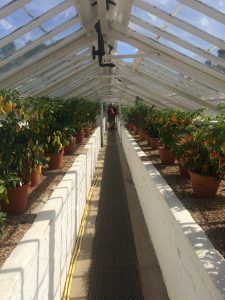It is hard not to fantasise about summer during these dark days, particularly when one of the very few jobs that really needs in the greenhouse doing propels you forward to the warmest days of the year. Right now not a lot needs sowing, but chillies do, their season so long that if they are useless if not sown in the very darkest and earliest days of the year, and then cosseted and coveted through the gloom, to persuade them that – no, you haven’t actually washed up in gloomy northern Europe, and yes you really are in the tropics. By the time we hit midsummer and beyond our greenhouses can do a fair impression of exactly the sort of conditions chillies require, long sunny days, warmth night and day – and that is why we bother with them now, because we know that at some point we will be able to relinquish our over-anxious parenting and let them fly, to an extent at least. I came across photographs I took in the magnificent chilli house at West Dean, taken a few good years ago and they reminded me that we grow these plants not only because they provide something unusual for the kitchen, but because they are beautiful as they do it.

This year I am trying Espelette from chilliworkshop.co.uk, a chilli with protected variety status that is used in many Basque dishes such as piperage, poulet Basquase and axoa de veux. It is apparently not particularly hot, with a Scoville rating of around 500-4000, which suits me because I do not like too much heat, and has a smoky, citrus-like flavour that hopefully you can actually taste because you wont have blown your tastebuds away. I really fancy growing their padron peppers too. I love peppers when used in the way padrons are, more as vegetables than as fiery heat, with only the occasional kick.
Whichever chillies you choose, now is the time to sow them. In fine seed compost sow two or three seeds to a small pot or cell, and then place them somewhere warm. A heated propagator is ideal, as it will maintain a constant temperature, whereas placing them next to for instance a radiator to keep them warm will lead to them being subject to blasts of heat and cold. Seedlings like dependable, gentle heat, even chilli seedlings. When they germinate the light levels will still be very low, and one way to really guarantee success with chilli seeds is to buy a grow light. Some heated propagators come equipped with grow lights, which emit the correct wavelength of light. This combination will ensure they grow well all through the darker days without getting drawn up and leggy. If you don’t have any lights, keep your chilli seedlings indoors and on the sunniest windowsill, but be careful to remove them to somewhere warmer on cold nights. Air behind curtains can get very cold indeed without us realising, and tender plants may not survive cold snaps there.
Once they have germinated you can pot them on into their own little pots and keep them somewhere bright and warm until the weather is warm enough for them to go out into the greenhouse. Keep potting them on – they will simply stop growing if they get rootbound. Remember not to pinch out the tips as you might with other plants to create bushiness, this can set chillies’ first fruiting back by up to a month, and they are naturally bushy plants that don’t need it. With a bit of luck by the height of summer your plants will be covered in colourful chilli fruits.


